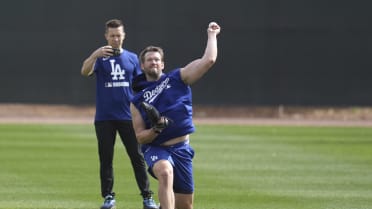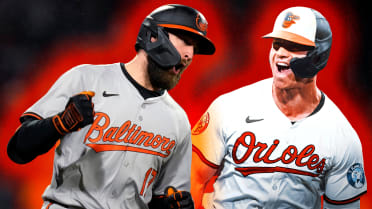Underrated Moyer came to grips with changeup
After embracing pitch, lefty enjoyed a successful career
Jamie Moyer had an amazing, perhaps even unique, talent for being underrated. No matter how many times people called him underrated -- and that word was used countless times in his 7,000-season career -- he remained underrated. No matter how much credit you want to give him, he was probably still better than you remember.
And we again play the comparison game (instead of giving you FanGraphs and Baseball Reference WAR, we average them out to give you a combo WAR):
Player 1: 254-186, 105 ERA+, 3,824 innings, 2,478 Ks, 1,390 Walks, 1.296 WHIP, 49.8 combo WAR
Player 2: 258-195, 105 ERA+, 3,908 innings, 2,342 Ks, 1,117 Walks, 1.323 WHIP, 49.0 combo WAR
Pretty darned similar, yes? Player 1 is newest Hall of Famer Jack Morris. Player 2 is Jamie Moyer, obviously, but discounting his final two seasons so we could get the innings to roughly match up. Moyer added 11 more wins, 14 more losses and various other things to his totals in those two seasons, when he was 47 and 49.
Again, just so we understand the rules of engagement for these Hall of Fame profiles -- I am not saying that Jamie Moyer's career should be compared to Jack Morris'; they were entirely different pitchers with entirely different Hall of Fame cases. I am saying that while Jack Morris' career left a powerful impression, Jamie Moyer's career did not. This wasn't Moyer's fault. He was better than you remember.
Jamie Moyer was one of those rare people who knew his destiny from the start. He grew up just north of Philadelphia, and he idolized Steve Carlton, a big lefty with one of the nastiest sliders in the history of the game. Moyer had his road map. He never really had another goal other than to be a big league pitcher. As a high school kid, he could throw pretty hard, he worked at it, he had a lot of success, he was baseball obsessed, it all seemed to be happening. Then came Jamie Moyer's first lesson in being Jamie Moyer: He wasn't drafted.
"Jamie has done nothing but get people out all his life," his father Jim griped to a local reporter. But, as we know, scouts don't really care if a high school pitcher can get high school hitters out. They cared that Moyer was thin and frail looking, that his fastball was in the high 70s or low 80s, that they didn't have a projection chart that showed any way for him to get Major League hitters out.
"He could be a prospect when he's 21, 22 years old," one scout rather kindly told the local paper. "But he's got to get a little faster."
Moyer went to St. Joseph's in Philadelphia where, like his father said, he did nothing but get people out. He developed an early version of the changeup that Bill James and Rob Neyer would rank the fourth best of all time in their book, "The Neyer/James Guide to Pitchers." The Cubs liked the changeup enough that they took Moyer in the sixth round.
And the Moyer Experience began. "We don't see you helping us," Rangers GM Tom Grieve told him in 1990 when the Rangers chose to release him.
"We don't win when you pitch," Cardinals manager Joe Torre told him in 1991 when they sent him to the Minors.
"We think you'd make a good pitching coach," Cubs Minor League director Bill Harford told him when they released him in 1992.
"We hope you can mentor some of our younger pitchers," Detroit management told him when they signed him … and then let him go a few months later.
When Moyer turned 30, he was 34-54 with a 4.56 ERA. Five different organizations had gotten rid of him (well, the Cubs had gotten rid of him twice), and once again the only person who seemed to think Jamie Moyer was a big league pitcher was, um, Jamie Moyer.
And even he began to doubt … as he explains in his book "Just Tell Me I Can't," there were two significant turning points in Moyer's career. One was that he started to see the late Harvey Dorfman, a sports psychologist who believed in the power of positive thinking. Moyer had always seen himself as a positive thinker -- after all, he'd overcome countless doubts to have any sort of big league career at all. But as Moyer talked with Dorfman, he slowly began to realize that negative thoughts had consumed him. He spent too much of his time thinking about things he couldn't do, like throw hard or get his curveball over consistently for strikes or put away hitters once he had them down in the count.
"You have control over that," Dorfman finally told him. "Over all of it."
You can call it confidence, call it trusting your stuff, call it one of the countless cliches that pitching coaches use, but Moyer did find something. Baltimore took a flyer on him in 1993, and Moyer pitched brilliantly at Triple-A Rochester, going 6-0 with a 1.67 ERA in eight starts. The Orioles called him up, and in his first outing he pitched 7 1/3 innings, gave up 10 hits … but only two runs. Next time out, he gave up 10 hits in 6 2/3 innings … but only one run.
And so it went. When the year ended, Moyer had given up more hits than innings pitched, but he hardly walked anybody and he didn't give up a lot of home runs, and he had his best year going 12-9 with a 3.43 ERA. He had found a way he could pitch in the big leagues.
The second turning point came about four years later. The Orioles let him go, the Red Sox picked him up and after a couple of months traded him to Seattle. The Mariners manager then was Lou Piniella, and the exchange the two had is probably my favorite part of Moyer's book:
"You're not throwing your changeup enough," Piniella told him.
Moyer didn't get it at first. He was throwing his changeup as much as ever; he knew it was the pitch that got him to the big leagues and then got him back to the big leagues.
"Really?" he asked.
"You're not throwing enough of them," Piniella reiterated. "And the ones you are throwing, you're not committed to. The changeup is who you ARE, for Chrissakes."
There's something bigger happening here. The number of changeups didn't really matter. What Piniella was telling Moyer was simply this: "You are a changeup pitcher. You can't throw too many changeups because it is at the heart of who you are, it's your best pitch, it's your out pitch, embrace that fact that you're not like other pitchers. Embrace who you are."
For the next seven seasons -- beginning when Moyer was 34 and ending when he was 40 -- Moyer embraced the changeup and was really good. He finished top six in the Cy Young Award voting three times and made his only All-Star Game appearance. He won 20 twice. He wasn't one of the true elites -- with Randy Johnson, Greg Maddux and Pedro Martinez -- but here is a fun comparison between him and three other lefties:
From 1997-2003:
Pitcher 1: 116-61, 3.92 ERA, 116 ERA+, 26.5 Baseball Reference WAR.
Pitcher 2: 110-53, 3.87 ERA, 112 ERA+, 26.3 WAR
Pitcher 3: 112-65, 3.40 ERA, 127 ERA+, 29.4 WAR
Moyer: 113-53, 3.75 ERA, 119 ERA+, 29.7 WAR
Pitcher 1 is Andy Pettitte. Pitcher 2 is David Wells. Pitcher 3 is Tom Glavine.
After his peak years with Seattle, Moyer just kept going and going and going. No, he didn't play 7,000 seasons, but he did play 25 of them. He is one of only 40 pitchers to throw more than 4,000 innings. At age 45 with Philadelphia, he went 16-7 with a 3.71 ERA as the Phillies went on to win the World Series. He wasn't great in that postseason -- he had one dreadful start against the Dodgers in the National League Championship Series -- but he put up a Moyer-like performance against Tampa Bay in the World Series, going 6 1/3 innings, giving up three runs and keeping Philadelphia in the game. Moyer didn't get the win, but the Phillies did win. That's probably fitting.
Jamie Moyer's 269 wins place him 35th on the all-time list, and if this was 20 years ago it is certain he would have gotten some Hall of Fame support simply for that. But the win has lost favor, and it's possible that Moyer will not get a single Hall of Fame vote on such a loaded ballot. That's probably fitting, too. Underrated to the end.
But let's not end it there. There's one other thing I like about Jamie Moyer: He invented an entire archetype. Every time a lefty without a big fastball comes along, he is inevitably called a "Jamie Moyer type." That means Moyer, even without the Hall of Fame, will live on.



